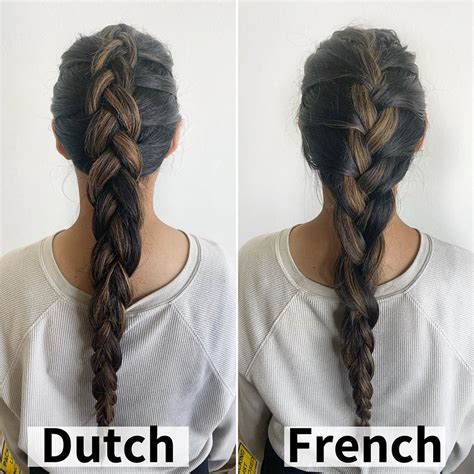Introduction
Dutch and French braids are two of the most popular braiding techniques, renowned for their beauty and versatility. However, these techniques differ significantly in their appearance, complexity, and suitability. This comprehensive guide delves into the intricate details of Dutch and French braids, providing hair stylists with a thorough understanding of their key differences.

Understanding Dutch Braids
Dutch braids, also known as inside-out braids, are characterized by their raised appearance. The hair is divided into three strands and the outer strands are crossed underneath the middle strand, creating a distinctive “bubble” effect. This technique requires a bit more tension and dexterity than French braids, making it suitable for experienced stylists.
Benefits of Dutch Braids:
- Eye-catching and voluminous
- Can hide hair extensions or thinning areas
- Provides a secure hold and can last for several days
Exploring French Braids
French braids, on the other hand, are known for their elegant and intricate pattern. The hair is divided into three strands and the outer strands are crossed over the middle strand, creating a more subtle and flat effect. This technique is generally easier to master than Dutch braids and is suitable for both beginner and intermediate stylists.
Benefits of French Braids:
- Versatile and suitable for various hair textures
- Can create a romantic and timeless look
- Relatively easy to learn and execute
Key Differences Between Dutch and French Braids
| Feature | Dutch Braid | French Braid |
|---|---|---|
| Appearance | Raised and bubbly | Flat and intricate |
| Technique | Outer strands crossed underneath | Outer strands crossed over |
| Complexity | More difficult for beginners | Easier for beginners and intermediates |
| Versatility | Suitable for hiding imperfections | More versatile for different hair types |
Practical Applications
Dutch and French braids have a wide range of applications, from everyday hairstyles to special occasions.
-
Dutch Braids:
- Festival and bohemian looks
- Voluminous buns and ponytails
- Updos that emphasize the braid’s texture
-
French Braids:
- Bridal and formal hairstyles
- Half-updos and side braids
- Pigtails and top knots
Effective Strategies for Perfect Braids
- Practice: The more you practice, the better you will become at achieving seamless braids.
- Sectioning: Divide the hair into even and manageable sections to facilitate smooth braiding.
- Tension: Maintain even tension throughout the braid to ensure a secure and polished look.
- Blending: Use a light hairspray or serum to blend the edges of the braid into the rest of the hair.
Common Mistakes to Avoid
- Uneven Sections: Unevenly divided sections can lead to a lopsided braid.
- Over-Tightening: Excessive tension can cause discomfort and breakage.
- Loose Ends: Secure the end of the braid firmly to prevent unraveling.
- Pulling Hair: Avoid pulling on the hair strands while braiding, as it can cause damage.
Pros and Cons: A Comparative Analysis
| Feature | Dutch Braid | French Braid |
|---|---|---|
| Pros: | ||
| * Voluminous | * Versatile | |
| * Secure | * Easy to learn | |
| * Hides imperfections | * Timeless and elegant | |
| Cons: | ||
| * More difficult | * Less voluminous | |
| * Can be uncomfortable with tight hair | * Can appear flat on fine hair |
Conclusion
Dutch and French braids are essential braiding techniques for hair stylists, offering a range of styles and applications. While Dutch braids provide a voluminous and eye-catching look, French braids are more versatile and suitable for various hair types. Understanding the key differences, benefits, and practical applications of these techniques enables stylists to create stunning and sophisticated hairstyles for their clients.
